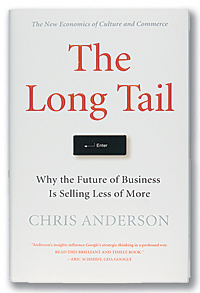Best Business Books: Media
Fractionalizers and Wikifiers
 Heather Chaplin and Aaron Ruby,
Heather Chaplin and Aaron Ruby,
Smartbomb: The Quest for Art, Entertainment, and Big Bucks in the Videogame Revolution
(Algonquin Books of Chapel Hill, 2005)
Glenn Reynolds,
An Army of Davids: How Markets and Technology Empower Ordinary People to Beat Big Media, Big Government, and Other Goliaths
(Nelson Current, 2006)
David A. Vise and Mark Malseed,
The Google Story: Inside the Hottest Business, Media, and Technology Success of Our Time
(Bantam Dell, 2005)
Chris Anderson,
The Long Tail: Why the Future of Business Is Selling Less of More
(Hyperion, 2006)
When cultural or technological changes create the need for a term to include a modifier to make its original meaning clear, the new phrase is called a “retronym.” Some examples are analog clock, birth mother, and snail mail. Another is mainstream media, a term now used to describe what we used to think of as simply media.
The reason we need that last retronym is, of course, the Internet. The Web gives everyone an outlet and creates a platform that makes little distinction between the multi-Pulitzered New York Times and a blog created last week by your next-door neighbor. All that separates them is money, history, and reputation. But in a world where many viewers get their news from Jon Stewart’s Daily Show, where a blogger brought down a giant of journalism like Dan Rather, and where the Times has suffered its own share of bruises, history and reputation are a double-edged sword. Technological change led to the last wave of media-related retronyms, and now two cultural forces are fast altering the media landscape: fractionalization and wikification.
The most compelling media writing of the year addressed how these two powerful, apparently unstoppable, and seemingly opposing forces are shifting the tectonic plates beneath the foundations of the industry. Fractionalization is media’s answer to Starbucks; every individual can come up with his or her own special combination of ingredients. As a result, we now live in a world of microhits and microcelebrities, where almost everyone is both a consumer and a creator of content. Meanwhile, wikification is bringing people together independently but collaboratively on an unprecedented scale to create and refine content of every conceivable sort. Hordes of volunteers have built Wikipedia into a reference tool with 10 times as many entries as the Encyclopedia Britannica and a surprisingly high level of accuracy.
Those who will thrive in this new environment understand that the forces of fractionalization and wikification are neither contradictory nor complementary, but intertwined. The most popular sites on the Internet, such as MySpace, eBay, and Amazon, succeed because stunning amounts of their content and structure are created and maintained by independent individuals at no cost to the company. Each user gets a highly individualized experience made possible through the participation of all users. The most significant challenge for all businesses in the next few years will not be responding to fractionalization and wikification, but rather mastering them to create a specific personalized interface that leverages the participation of everyone.
This year’s best media books describe the principles well. It is not a coincidence or an oversight that none of the titles on my list focus on traditional media. Some good books did come out, filled with careful reporting and serviceable assessments of the ups and downs of network television and movies. But they all seemed a little antiquated and backward-looking.
The books I have selected have their flaws. All four of them feel padded and are overenthusiastic, even Panglossian, about their pet theories. But each is worth thoughtful attention, and together they provide a context that media businesses can and should factor into their strategic thinking.
 Not Child’s Play
Not Child’s Play
Games do not occupy the bandwidth in popular consciousness that music or movies do, but when it comes to revenue, they give every other type of media business a run for its money. U.S. computer and video-game software sales reached $7 billion in 2005, according to the Entertainment Software Association. Games are also important because of their “multiple platforms” and cross-pollination imperatives for entertainment content. Almost every action film and children’s movie has a game version, and many games have inspired movies.
Computer games are mesmerizing. Like other popular fads (hula hoops, Rubik’s Cubes), they are simple to learn but difficult to master, with multiple levels of achievement. Smartbomb: The Quest for Art, Entertainment, and Big Bucks in the Videogame Revolution, by Heather Chaplin and Aaron Ruby, describes how games have embedded themselves in the popular culture.
The Sims is a good example. Its appeal is global, with versions in 14 languages — from Thai to Italian. One of Smartbomb’s most significant revelations was that the game’s creators did not have to make changes to the characters or environments of the Sims games to make them feel familiar to players in different countries. Instead, they used U.S. television shows as their template. Sitcoms like Friends may not be an accurate depiction of life in America, but because these programs are shown all over the world, they have become a cultural touchstone that makes everyone feel at home. “The Sims takes place within a culture of Americana, a culture and society that never really existed, not even in America, but one with which people all over our media-saturated globe can identify,” write the authors.
They explain that games, like movies, are not “constrained by the narrowness of possibility space.” Movies have made us believe in aliens and modern-day dinosaurs. We’ve seen interplanetary travel, we’ve seen the Empire fight the Jedi, and we have seen the sinking of the Titanic. And yet, a significant portion of the audience wants more — they want to interact with and control those stories. The appeal of games is that they create a direct, highly personal connection to the consumer.
Some games have the ability to learn each player’s tastes and desires, the same way TiVo and Amazon can prompt users to choose TV shows or books that might suit them. Video games are where fractionalization and wikification intersect, and Smartbomb illuminates both phenomena. Games are highly individualized, but they are also strong community builders. And everyone helps to create the content. After only a few months of operation, Star Wars Galaxies, an online game, had more “citizens” than Birmingham, Ala., or Anaheim, Calif. If you do not think games are a subset of media, listen to this Xbox executive, who says he is trying to take consumers from movies and television: “We’re competing for leisure time here.”
Smartbomb delivers invaluable insights into the video-game industry’s astonishing appeal, breadth, and innovation. Further, the book illuminates the way that the industry, in appropriately viral form, is transcending its origins as a diversion for college kids and bar patrons. The U.S. Army, for example, is using video-game technology to develop training materials and is even drawing on games to develop the kinds of strategies and communication capabilities 21st-century soldiers need. Similarly, there is enormous potential for expanding the social networking and interaction that began with fantasy environments like EverQuest and Star Wars Galaxies into online communities built around a range of ideas and characters as varied as those in movies or books.
Wikifying Geniuses
The same two themes resonate through An Army of Davids: How Markets and Technology Empower Ordinary People to Beat Big Media, Big Government, and Other Goliaths, by University of Tennessee Law Professor Glenn Reynolds, founder of the popular blog Instapundit.com. Bloggers write about what matters to them, and topics range from the broadest issues of politics and policy to the narrowest personal experiences and preoccupations. The mainstream media (MSM), by contrast, seek out the lowest common denominator to interest as many people as possible. Professor Reynolds’s main insight is that “small is the new big,” but he tries to extrapolate too much from that point. His claims that individual-centered technology will dramatically improve counterterrorism efforts and extend the human life span are very rosy, to say the least. Still, as enthusiastic as Professor Reynolds is about the empowering aspect of blogs, he recognizes that technology helps the bad guys along with the good ones.
His discussion of blogs and their appeal to both their creators and their readers is very worthwhile. Blogs, in his view, broaden the community of discourse to include the community of interest, a perfect example of the combination of fractionalization (almost all blogs are created by individuals) and wikification (the millions of bloggers have created a media category with stunning breadth of coverage). As the mainstream media cut back on international coverage, blogs take up the slack. An Army of Davids describes how an Iraqi blogger reported war crimes that Professor Reynolds subsequently wrote about, alerting an American military blogger in Iraq, who then reported the crimes to authorities, leading to a soldier’s court-martial.
The Google Story: Inside the Hottest Business, Media, and Technology Success of Our Time, by David A. Vise and Mark Malseed, makes the point that Google may be the ultimate wikifier. It is astonishing to realize that one of the biggest and fastest-growing companies in the world has never spent a penny marketing its search service, which is given away to users. Google’s revenues come from advertisements that have two unprecedented advantages: 1) They can be sold to anyone with a budget of any size and can be placed in outlets of any size; 2) The ads are uniquely targeted to ensure that they will appear only to those who are likely to be most interested in them. The genius in Google’s business model is that the world is generating the pages for its ads and the content for its searches.
The core of Google’s wiki-ness lies in its search function, the ranking system of which relies on users. Further, Google does not need to create content; that is done continuously by others. The more content that is added to the Internet, the more Internet users need Google to find it — and the more valuable is Google’s ranking and its ability to target ads on the basis of what people are searching for. The world also serves as Google’s focus group; Google wikifies its consumers into beta testers by encouraging them to try out new services, provide feedback, and even create their own add-ons.
Google’s motto, “Don’t be evil,” turns out to be not just a corporate value but an indispensable part of the brand. The company’s decision not to permit ads for alcohol, pornography, or cigarettes is part of what makes it trustworthy. Google is successful because users trust it to deliver legitimate search results not skewed by relationships with advertisers.
However, that trust was shaken in 2004 when the company launched its popular free Gmail accounts, and then used its own technology to search the content of e-mail to deliver targeted advertising to users alongside their e-mail messages. Users rose up in fury and gave Google a painful reminder of the importance of maintaining their trust.
Regardless, the company continues to be widely admired. Thinking of joining up? Messrs. Vise and Malseed include a copy of Google’s daunting job application in the book. One line asks for a haiku describing possible methods for predicting search traffic seasonality.
Another book about Google published this year, John Battelle’s The Search: How Google and Its Rivals Rewrote the Rules of Business and Transformed Our Culture (Portfolio, 2005), also covers the sociology and policy implications of Google’s search algorithms. It is worthwhile. But The Google Story also covers the business, history, culture, and strategy of this company that in less than 10 years went from an idea to a universally recognized brand. Google’s triumph in taking over the search functions from rivals AOL and Yahoo (and its mistake in failing to predict the reaction to its Gmail advertising practices) makes compulsory reading.
 Fractionalizing Amateurs
Fractionalizing Amateurs
The Long Tail: Why the Future of Business Is Selling Less of More, by Wired magazine Editor Chris Anderson, really has only one point to make, and it’s stated in the title. But it is a crucial one, and Mr. Anderson is a lively writer with some great examples. Mr. Anderson says we have witnessed the end of the culture of blockbusters, as markets fragment into countless niches. Today’s top-rated television shows and music, for example, get nowhere near the market penetration of the top-ranked comparable media in the 1970s. The Internet has enabled smart entrepreneurs to bring niches within reach of the consumer, revealing latent demand for otherwise noncommercial content.
This year’s best and most influential media title, The Long Tail describes how “infinite shelf space” and “abundance” on the supply side of the economy — think Amazon and Netflix — are transforming the expectations of the demand side. Hits, says Mr. Anderson, will always be important. They serve as a source of common culture around which narrowly targeted markets can form. That is, hits are surrounded by clusters of “micro-hits” that are popular enough to be profitable. Mr. Anderson then shows how the concept of the management of scarcity is changing. Currently, for example, the manager of even a very large bookstore must cope with limited shelf space by allocating it to the books that are likely to sell the most copies. But technology has created an economics of abundance: Amazon’s cyber “shelves” contain every book in print, and every CD and DVD as well.
Netflix and other online sellers also have unlimited shelf space. People can get exactly what they want, and, as it turns out, they want everything. Amazon and Netflix have reversed the statistics of their bricks-and-mortar competition. At conventional stores, 68 percent of the sales consist of the 100 most popular products. At Netflix, meanwhile, 62 percent of the rentals are “micro-hits.” Every single one of Netflix’s 55,000 titles rents at least once a quarter. Even if Blockbuster could stock all of those titles (the typical outlet offers 3,000), the discs might languish on the shelf because customers looking for a quirky foreign drama wouldn’t put in the considerable effort it would take to find it.
Netflix helps create demand for niche titles by making it easy for customers to track down what they want and by making recommendations based on the customer’s past choices. Netflix combines infinite shelf space with real-time information. And that information comes from the company’s other customers, who provide not only their rental data but also their opinions, which, it turns out, other consumers like to read and use. Mr. Anderson says the process boils down to three steps: Make it, get it out there, and help me find it. The increase in the range of choices on television has made it very difficult for viewers to find exactly what they want. What is needed is a Google for television to eliminate that frustrating march through the stations and to give audiences an easy way to find what is most likely to interest them.
Things are changing so rapidly that it is not surprising that the most provocative and insightful writing on the media business I saw this year was not in a book but in two magazine articles: John Cassidy’s “Me Media” (New Yorker, May 15, 2006) and Philip Weiss’s “A Guy Named Craig,” about the founder of Craigslist.com (Jan. 16, 2006, New York magazine). Both were more than lively and astute descriptions of astonishing success stories; they were indicators of new business models and harbingers of potentially devastating collateral damage to MSM.
Facebook.com, the subject of Mr. Cassidy’s article, is a Web site for personal pages created by college students. It began in February 2004 at Harvard, and within seven months, it had a quarter of a million users. They were the kind of people advertisers dream of: bright, young, educated, sophisticated consumers of media and technology. The key elements of Facebook’s appeal seem to be access to information within a sense of community and privacy. Because only college students have access to the site and because participants have control over which of their items are public and which are for approved friends only, Facebook users feel safe. Instead of finding people with whom they share a dorm or a class, students can find fellow vegetarians, reggae fans, or Republicans. However, Facebook’s growing pains should be a cautionary tale for anyone hoping to replicate its system. Some students post photos of parties that include classmates who are not happy to have those moments made public. And the open-to-anyone policy of Myspace.com has led to concerns about predators who have contacted minors through the site. But, as Mr. Cassidy notes, these networking systems tap into people’s need for connection in a way that MSM never could.
The real cautionary tale, though, is the story of Craigslist, an 11-year-old service for posting classified ads for jobs, apartments, used cars, etc., as well as personal ads and restaurant recommendations. It is free to use, except for help-wanted ads in three cities and apartment ads in one. Craigslist is intentionally low-tech in look and easy to use, traits that are an essential part of its credibility and identity. The paradox of Craigslist’s success is that founder Craig Newmark does not care about money, which is why the site’s users trust it. Craigslist, which is based in San Francisco, costs very little to run, and Mr. Newmark already has plenty of money from previous dot-com success. Even if he were interested in selling the site, the sale itself would damage the brand’s most significant identifying factor. How can MSM compete with that? Not easily. Craigslist.com gets more than 3 billion page views per month, ranking it seventh on the Net. And, according to Mr. Weiss, Bay Area newspapers are losing as much as $50 million a year in classified-ad revenue to Craigslist. The issue here is not whether Craigslist will make as much money as it could if maximizing revenue were its goal. The issue is how Craigslist prevents other businesses from maximizing revenue. It does not matter that competing with MSM for classified-ad revenue is not a priority for Craigslist; the fact is that it does, and very effectively.
Still, there will always be a market for professional media. YouTube.com, the site where anyone can post short videos (and which was purchased in October by Google), may showcase footage from international conflicts alongside college students lip-synching in their underwear, skateboarders crash-landing, and babies laughing, but people still want to get news from those who are established as trustworthy and knowledgeable, and entertainment from those who have talent and charisma. For advertisers, the challenge will be to find a way to take what marketers have learned from consumers and what the consumers share with one another to deliver information to the people who are most interested in it. For content providers, the challenge will be to find a way to make consumers feel involved and connected, to help them find a sense of community, to let them participate, to take the best of what they contribute and help them communicate it to one another and the world. (Those lessons should be on full display in what promises to be next year’s most influential book: Wikinomics, by Don Tapscott and Anthony D. Williams. The book’s subtitle, by the way, will be determined by visitors to www.wikinomics.com, a superbly wikonian example of form driving content.)
One of the most popular Web sites for creating blogs is Blogger.com (now owned by Google). Blogger exemplifies both fractionalization, with millions of mini-publications reaching passionate but small audiences, and wikification, as all of those publications are a part of one very large category of content. Interestingly, blogs are one kind of content for which Google’s famous market-based search algorithms are not effective. Because blogs change so rapidly, a search based on the number of external links will not work; blog posts are a moving target. Google has developed a separate search engine for blogs, but so far it has not been as successful as a competitor’s blog search engine, Technorati. Perhaps 10 years from now, all of Google will have been eclipsed by Technorati, and we’ll be reading a business book about how that happened.
As today’s media businesses redefine their niches and delivery formats, the ones that will succeed are those that find the right balance between the hits that appeal to many people and the micro-hits that appeal to enough people to earn their keep. The media businesses that triumph will be the ones that find a way to offer the broadest range of options and the easiest ways to sort through them. Retronyms develop when new technologies carve out new categories. What used to just be “the media” must now consider what it means to be “mainstream” and especially how to leverage its greatest assets — experience, expertise, professionalism, access, and reputation — as it learns to take advantage of the channels and opportunities to meet the specific needs of its audience, as a whole and as individuals with particular interests and growing expectations for content that they get to choose and even help to create.![]()
Author profile:
Nell Minow (nminow@thecorporatelibrary.com) writes about movies, TV, and the Internet and is the Media Mom columnist in the Chicago Tribune. She is the cofounder and editor of the Corporate Library, a clearinghouse for information and analysis on corporate governance.


